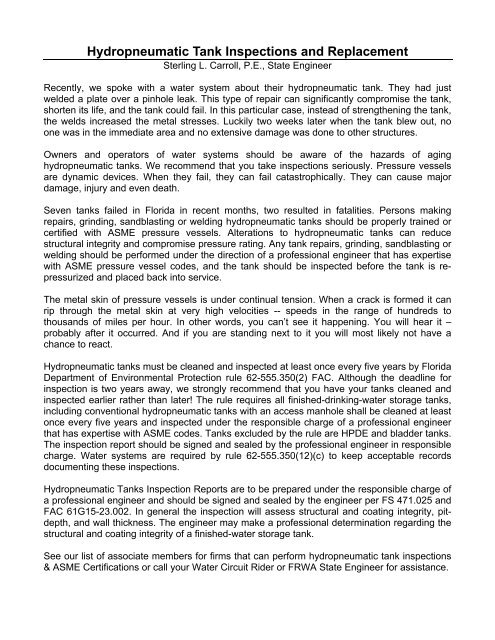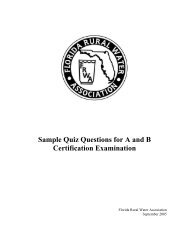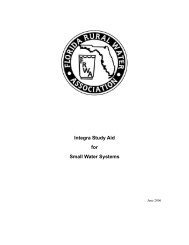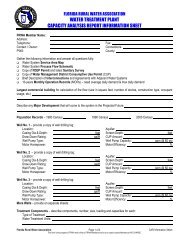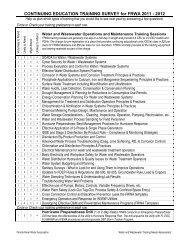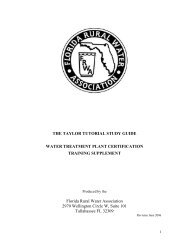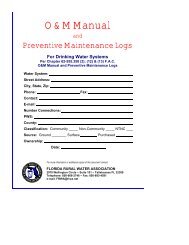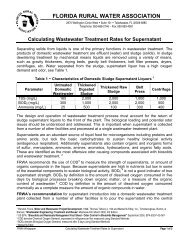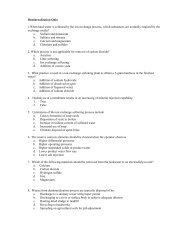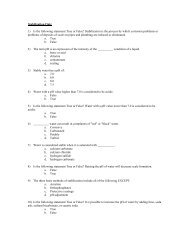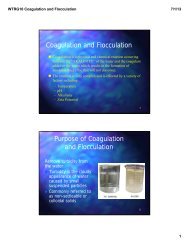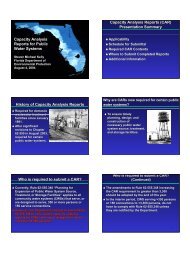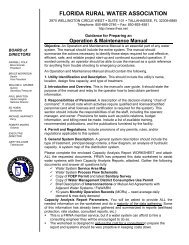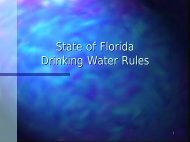Hydropneumatic Tank Inspections and Replacement - Florida Rural ...
Hydropneumatic Tank Inspections and Replacement - Florida Rural ...
Hydropneumatic Tank Inspections and Replacement - Florida Rural ...
You also want an ePaper? Increase the reach of your titles
YUMPU automatically turns print PDFs into web optimized ePapers that Google loves.
<strong>Hydropneumatic</strong> <strong>Tank</strong> <strong>Inspections</strong> <strong>and</strong> <strong>Replacement</strong><br />
Sterling L. Carroll, P.E., State Engineer<br />
Recently, we spoke with a water system about their hydropneumatic tank. They had just<br />
welded a plate over a pinhole leak. This type of repair can significantly compromise the tank,<br />
shorten its life, <strong>and</strong> the tank could fail. In this particular case, instead of strengthening the tank,<br />
the welds increased the metal stresses. Luckily two weeks later when the tank blew out, no<br />
one was in the immediate area <strong>and</strong> no extensive damage was done to other structures.<br />
Owners <strong>and</strong> operators of water systems should be aware of the hazards of aging<br />
hydropneumatic tanks. We recommend that you take inspections seriously. Pressure vessels<br />
are dynamic devices. When they fail, they can fail catastrophically. They can cause major<br />
damage, injury <strong>and</strong> even death.<br />
Seven tanks failed in <strong>Florida</strong> in recent months, two resulted in fatalities. Persons making<br />
repairs, grinding, s<strong>and</strong>blasting or welding hydropneumatic tanks should be properly trained or<br />
certified with ASME pressure vessels. Alterations to hydropneumatic tanks can reduce<br />
structural integrity <strong>and</strong> compromise pressure rating. Any tank repairs, grinding, s<strong>and</strong>blasting or<br />
welding should be performed under the direction of a professional engineer that has expertise<br />
with ASME pressure vessel codes, <strong>and</strong> the tank should be inspected before the tank is repressurized<br />
<strong>and</strong> placed back into service.<br />
The metal skin of pressure vessels is under continual tension. When a crack is formed it can<br />
rip through the metal skin at very high velocities -- speeds in the range of hundreds to<br />
thous<strong>and</strong>s of miles per hour. In other words, you can’t see it happening. You will hear it –<br />
probably after it occurred. And if you are st<strong>and</strong>ing next to it you will most likely not have a<br />
chance to react.<br />
<strong>Hydropneumatic</strong> tanks must be cleaned <strong>and</strong> inspected at least once every five years by <strong>Florida</strong><br />
Department of Environmental Protection rule 62-555.350(2) FAC. Although the deadline for<br />
inspection is two years away, we strongly recommend that you have your tanks cleaned <strong>and</strong><br />
inspected earlier rather than later! The rule requires all finished-drinking-water storage tanks,<br />
including conventional hydropneumatic tanks with an access manhole shall be cleaned at least<br />
once every five years <strong>and</strong> inspected under the responsible charge of a professional engineer<br />
that has expertise with ASME codes. <strong>Tank</strong>s excluded by the rule are HPDE <strong>and</strong> bladder tanks.<br />
The inspection report should be signed <strong>and</strong> sealed by the professional engineer in responsible<br />
charge. Water systems are required by rule 62-555.350(12)(c) to keep acceptable records<br />
documenting these inspections.<br />
<strong>Hydropneumatic</strong> <strong>Tank</strong>s Inspection Reports are to be prepared under the responsible charge of<br />
a professional engineer <strong>and</strong> should be signed <strong>and</strong> sealed by the engineer per FS 471.025 <strong>and</strong><br />
FAC 61G15-23.002. In general the inspection will assess structural <strong>and</strong> coating integrity, pitdepth,<br />
<strong>and</strong> wall thickness. The engineer may make a professional determination regarding the<br />
structural <strong>and</strong> coating integrity of a finished-water storage tank.<br />
See our list of associate members for firms that can perform hydropneumatic tank inspections<br />
& ASME Certifications or call your Water Circuit Rider or FRWA State Engineer for assistance.
<strong>Hydropneumatic</strong> <strong>Tank</strong> Rupture<br />
<strong>Hydropneumatic</strong> <strong>Tank</strong> Rupture
<strong>Hydropneumatic</strong> <strong>Tank</strong> Rupture<br />
<strong>Hydropneumatic</strong> <strong>Tank</strong> Rupture
<strong>Hydropneumatic</strong> <strong>Tank</strong> Rupture<br />
<strong>Hydropneumatic</strong> <strong>Tank</strong> Rupture


